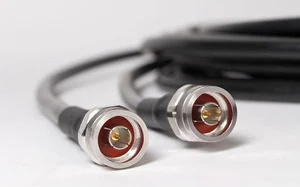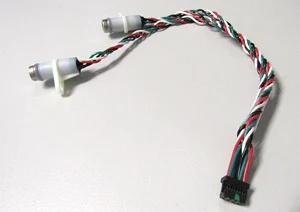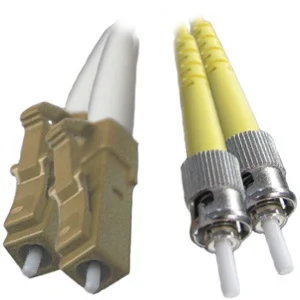Network cables are used for communication systems throughout the world. Using the right cable will ensure optimum performance of the network. Therefore, whether to use coaxial cable vs twisted pair cable vs fiber optic cable will depend on the communication system being installed.
Each type of cable serves a distinct purpose, has specific benefits, and certainly drawbacks if the wrong cable is installed. There are a number of factors to consider in choosing the correct cable for your network to achieve optimum performance, including:
- Environmental factors
- Distance
- Bandwidth
- Transmission
- Capacity
Here is a handy guide briefly outlining the advantages and disadvantages of each:
Coaxial Cable
 Its extensive use throughout countless homes has made coaxial cable a familiar sight to many. In use since the early 20th century, it is still used by cable operators, telephone companies, and internet providers to convey communications—data, video, and voice. It is noted for its reliable and accurate transmission.
Its extensive use throughout countless homes has made coaxial cable a familiar sight to many. In use since the early 20th century, it is still used by cable operators, telephone companies, and internet providers to convey communications—data, video, and voice. It is noted for its reliable and accurate transmission.
Coaxial cable has an inner conductor that is surrounded by an insulating layer, which has conductive shielding around it. For some applications, even the outer jacket of the cable may be insulated. The center conductor carries the electrical signal. The shielded design of the cable allows for transmission of data rapidly through its copper core without interference from environment factors.
Coaxial cable assemblies are easily installed and exceptionally durable. Because it performs best over shorter distances, coaxial cable is ideally suited for home installations and average capacity data transfer networks. Signal loss is a disadvantage when using coaxial over great distances, and signal leakages are prone at points of ingress or egress, i.e., at the point of contact between male and female connectors. Leakage causes distortion and the signal is fuzzy or snowy. Speed fluctuations in broadband networks can also occur in the transfer of data during periods of high usage.
Advantages
- Very durable
- Performs best over short distance
Disadvantages
- Signal loss over long distance
- Signal leak at points of egress
- Speed fluctuations under heavy usage
Twisted Pair Cable
 As the name implies, twisted pair cable is literally made by intertwining two or more separate insulated wires together and running them parallel to each other. The twisted wires have interference cancelling properties. Thus, it is suitable for data and voice infrastructures over short distances as the cable reduces the effect of electromagnetic interference on electronic signals. It’s also more pliable and easier to install than coaxial cable.
As the name implies, twisted pair cable is literally made by intertwining two or more separate insulated wires together and running them parallel to each other. The twisted wires have interference cancelling properties. Thus, it is suitable for data and voice infrastructures over short distances as the cable reduces the effect of electromagnetic interference on electronic signals. It’s also more pliable and easier to install than coaxial cable.
Two types of twisted pair cables are used: shielded and unshielded. A Shielded Twisted Pair (STP) has a fine wire mesh surrounding the wires to protect the transmission; Unshielded Twisted Pair (UTP) does not. The latter is the more common of the two types, and is used in Ethernet installations and is often utilized in applications for both residential and business. Shielded cable is used in telephone networks, as well as network and data communications to reduce outside interference and crosstalk, and is designed to assist in grounding. Of the two, UTP cables are less expensive than STP cables, and maintenance requirements are lower as they do not rely on an outer shield. Though UTP can transmit data as fast as STP cables, they are prone to noise, more so than STP cables.
Twisted pair cables are the most cost-effective option among coaxial and fiber optic, but there is also lower bandwidth and higher attenuation, i.e., the greater the distance the lower the performance. They are also susceptible to wear and tear, and must be routinely maintained. Best to use twisted pair cable in any area where there is not a high degree of electromagnetic interference.
Advantages
- Cost-effective
- Pliable and easy to install
- Performs best over short distance
Disadvantages
- Lower durability (must be routinely maintained)
- Susceptible to EMI
- Higher attenuation
Fiber Optic Cable
 Fiber optic cable differentiates from coaxial and twisted pair cabling in several ways. For starters, its core consists of optic fibers rather than copper. More impressively, data is transmitted by light rather than an electrical or electronic signal. Transmissions can travel at a greater distance at a much faster pulse—26,000 times faster than twisted pair. Optical fibers are insulated in plastic coating within a protective plastic outer layer or tubing. Optical fibers are also flexible and can be bundled as cables, which make them advantageous for long-distance communications, because light propagates through the fiber with little attenuation compared to electrical copper cables.
Fiber optic cable differentiates from coaxial and twisted pair cabling in several ways. For starters, its core consists of optic fibers rather than copper. More impressively, data is transmitted by light rather than an electrical or electronic signal. Transmissions can travel at a greater distance at a much faster pulse—26,000 times faster than twisted pair. Optical fibers are insulated in plastic coating within a protective plastic outer layer or tubing. Optical fibers are also flexible and can be bundled as cables, which make them advantageous for long-distance communications, because light propagates through the fiber with little attenuation compared to electrical copper cables.
Fiber optic comes in single-mode or multimode connections. The former allows only one mode of light to transmit at a time through the core, which makes for a higher bandwidth. This has the effect of decreasing the number of light reflections, resulting in low attenuation and allowing data to travel further, faster. Single-mode connections are used at universities, colleges, and other educational institutions CATV networks and in telecom.
Multimode connections have a larger core diameter which lets multiple modes of light transmit at once.
The number of light reflections through the core increase as they travel, allowing more data to pass through. However, this does cause high dispersion, which means lower bandwidth, higher attenuation and a reduction in signal quality the further it travels. Multimode connections are ideal LAN, security systems, and other fiber networks for high speed communications over shorter distances.
Fiber optic cabling is the most expensive of the three types of cabling. Optical fibers are fragile and susceptible to being cut or damaged during installation or construction activities. Which also means it is not as pliable as copper, and if bent or twisted too much or at the wrong angle and it will break. Finally, transmission of data over longer distance requires amplification of optical signals through components such as EDFAs to be added to the network, further increasing costs. Despite these drawbacks, if it is within your budget, fiber optic cabling is more efficient and has higher transmission capacity.
Advantages
- Can be bundled together
- EMI-resistant
- Performs well over long distances
Disadvantages
- More expensive
- Harder to install
- Susceptible to being cut or damaged
Build a Better Network Assembly or Harness with JEM Electronics
With more than 3 decades of experience in designing and producing custom cable assemblies and wire harnesses, JEM Electronics is equipped to help you build the best product for your application. If you have any questions about your next project, contact the experts at JEM today!


